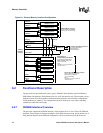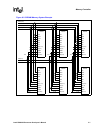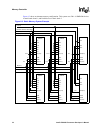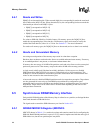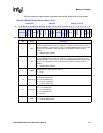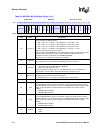
Intel® PXA255 Processor Developer’s Manual 6-3
Memory Controller
partition pairs: the 0/1 pair and the 2/3 pair. The partitions in a pair must be identical in size and
configuration. The two pairs may be different (for example, the 0/1 pair can be 100 MHz SDRAM
on a 32-bit data bus, while the 2/3 pair can be 50 MHz SDRAM on a 16-bit data bus).
The processor SDRAM Controller includes the following signals:
• 4 partition selects (nSDCS[3:0])
• 4 byte selects (DQM[3:0])
• 15 multiplexed bank/row/column address signals (MA[24:10])
• 1 write enable (nWE)
• 1 column-address strobe (nSDCAS)
• 1 row-address strobe (nSDRAS)
• 1 clock enable (SDCKE[1])
• 2 clocks (SDCLK[2:1])
• 32 data (MD[31:0])
The processor performs auto-refresh (CBR) during normal operation, and supports self-refreshing
SDRAM during Sleep mode. An SDRAM auto-power-down mode bit can be set so that the clock
and clock enable to SDRAM are automatically de-asserted whenever none of the corresponding
partitions is being accessed.
The processor supports x8, x16, and x32 SDRAM chips.
Upon enabling an SDRAM partition, a mode register set command (MRS), see Section 6.5.6, is
sent to the SDRAM devices by writing to the MDMRS register. The PXA255 processor adds
support for low-power SDRAM by giving software access to the Extended Mode Register via the
MDMRSLP register.
MRS commands always configure SDRAM internal mode registers for sequential burst type and a
burst length of four.
The CAS latency is determined by the DTC0 or DTC2 field of MDCNFG.
6.2.2 Static Memory Interface / Variable Latency I/O Interface
The static memory and variable latency I/O interface has six chip selects (nCS[5:0]) and 26 bits of
byte address (MA[25:0]) for accesses of up to 64 Mbytes of memory in each of six banks. Each
chip select is individually programmed for selecting one of the supported static memory types:
• Non-burst ROM or Flash memory is supported on nCS[5:0]
• Burst ROM or Flash (with non-burst writes) is supported on nCS[5:0]
• Burst and non-burst SRAM is supported on nCS[5:0]
• Variable Latency I/O is supported on nCS[5:0]
• Synchronous static memory is supported on nCS[3:0]
The Variable Latency I/O interface differs from SRAM in that it allows the data-ready input signal,
RDY, to insert a variable number of wait states. For all static memory types, each chip select can be
individually configured to a 16-bit or 32-bit-wide data bus. nOE is asserted on all reads, nPWE is










